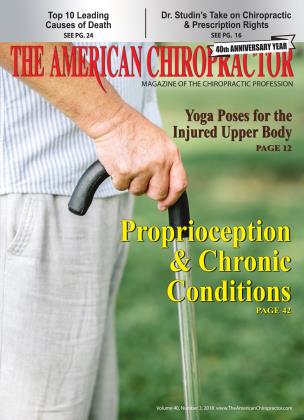Medical Cannabis (Vs Opioids)
FEATURE
Part three in a series
Jeffrey Tucker
DC, DACRB
Some people feel that cannabis may be bad for your body and some people feel that it’s helpful for your body. The stigma of using marijuana is diminishing because medical cannabis is here to stay. People realize that they don’t have to avoid it anymore, and they know they are allowed to try cannabis as medicine or recreation. As a profession, we can focus on the literature as well as what our personal and patient experiences have to offer.
Can chiropractors write a prescription for a medical marijuana card? No! However, since we see many patients who have chronic pain sometimes caused by injuries (falls, sports injuries, work-related, MVA, etc.) and other chronic illnesses, it makes sense that we would want patients to try something new that may be helpful. Patients with chronic pain are asking questions and looking for answers to questions such as, “What is this pain about?” and, “What can I leam from this pain?” Imagine recommending cannabis as a way to provide answers that could help them resolve their painful problems. Some patients have felt the “high” from cannabis with THC acts as an aide to helping them hear intuitive messages that guide their decision-making process.
Recall from the previous articles that marijuana tends to be high in THC and low in CBD, whereas hemp is high in CBD and low in THC. Hemp’s importation is allowed as long as the plant’s THC level is below 0.3%. Hemp seeds can be eaten raw, turned into flour, sprouted, and made into oils. Hemp seed oil is the only bioavailable crop with a perfect omega 6 to omega 3 ratio. Hemp is high in fat, low in carbs, contains a moderate amount of protein, and is high in several essential minerals, including vitamin E, potassium, calcium, zinc, and magnesium (Nutritionaldata. self, com/facts/custom/629104/2). Hemp-derived CBD may have therapeutic utility in antiinflammation, anti-oxidative stress, and neuroprotective effects, including Parkinson’s disease, diabetes, rheumatoid arthritis, Alzheimer’s disease, ischemia-reperfusion injury, multiple sclerosis, epilepsy, andALS (ProjectCBD.org).
When 95 percent of people prefer it over opioids, this means as a doctor to me, the endocannabinoid system needs to be taught in our schools 5 J
Opioids and Cannabis
The idea of chiropractic being a natural therapy for chronic pain patients as an alternative to addictive and life-threatening opioids has been well launched in the media. Let the medical doctors keep the opioids. ChiropractorsForCannabis.com is coming (and manipulation)! A University of California at Berkeley research team published in Cannabis and Cannabinoid Research a study that asked people, “What are you able to do with opioids versus cannabis?” Of the more than 3,000 patients that answered the survey, 97% were able to get off and decrease opioid use, and 95% who answered preferred cannabis over opioids for use. When 95% prefer it instead of opioids, this means to me, as a doctor, that the endocannabinoid system needs to be taught in our schools. Cannabis education needs to be improved, and we need to have working relationships with medical doctors who understand how to comanage these patients.
Another study performed by Brightfield Group in Chicago, Illinois, specifically looked at just CBD. They found that 80% were able to get off their current medication and use CBD products, whether it was from hemp or from cannabis, to stop taking medication that they traditionally used, which is far safer.
A collaborative study by the National Institute on Drug Abuse and the Rand Corporation found a decrease in opioid prescriptions in medical cannabis states. If chiropractic is suggesting it has a role in pain relief versus opioids, then I suggest we be open to cannabis as an exit drug for opioids.
A University of New Mexico study suggests that cannabis could be a tool in the opioid epidemic. The study observed 37 habitual, opioid-using, chronic pain patients who chose to enroll in the state’s medical cannabis program, and 29 patients with similar conditions who chose not to enroll in the program. Researchers found a 47% reduction in daily opioid dosage in the patients who also used cannabis, (https://www.ganjapreneur. com/topic/new-mexico/)
The medical cannabis program enrollment was also associated with 17 times higher age-and-gender-adjusted odds of stopping opioid prescriptions and five times higher odds of reducing daily opioid dosages. The patients who were not enrolled in the medical cannabis program actually had a 10% increase in self-reported daily opioid dosages over the 21-month observation period.
New research is emerging from all over the world about cannabis. As doctors, our concern is about public safety, formulations that do what they say, dosage, and delivery quality. Patients will ask you if they can use this type of cannabis medication instead of whatever they currently take for a variety of symptoms, including menstrual cramps, migraine headaches, etc. My personal answer is, “It is a legitimate type of medication, and if we are specifically talking about your condition, it’s an option.” Yes, cannabis would be something that a patient could try instead of opioids, and perhaps the patient should get a recommendation from a physician who is able to do that. The need to apply bioscience to the cannabis industry for the delivery of products from the chiropractic profession to the public is underway. In the future, I will discuss specific conditions, formulations, and products that chiropractors can learn about to stay on the leading edge of medical cannabis.
Dr. Jeffrey Tucker practices in West Los Angeles, California. He is the current secretary/treasurer of the AC A Rehab Council. Dr Jeffrey Tucker (Sponsored by AC A Rehab Council) “Utilizing the CLXRehab Bands ”.
His website is www.DrJeffreyTucker.com.
 View Full Issue
View Full Issue






